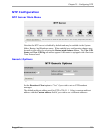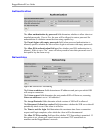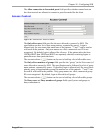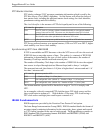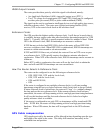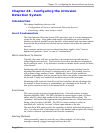
Chapter 27 - Configuring IRIGB And IEEE1588
Chapter 27 - Configuring IRIGB And IEEE1588
Introduction
This chapter familiarizes the user with:
• IEEE 1588 Configuration
• IRIGB Configuration
• Viewing IRIGB and IEEE1588 Status
IEEE1588 Fundamentals
The IEEE 1588 working group Precise Timing Protocol (PTP) standard details a
method of synchronizing a clocks over networks, including Ethernet. The
RuggedRouter provides a special hardware assisted PTP capability as provided by the
RuggedCom PTP card. When used in conjunction with the cards Global Positioning
System (GPS) receiver, the router can provide nanosecond accuracy via IEEE1588.
Additionally, IEEE1588 may be used (in GPS failure situations) to synchronize to a
remote source and provide accurate time for IRIG-B.
PTP Network Roles
The IEEE 1588 standard describes regular clocks as devices having a single PTP port
that can issue and receive PTP messages. PTP boundary clocks are clocks have have
multiple PTP ports, offering the ability to serve time to more than one subnet at a
time. The RuggedRouter can serve as a regular clock and communicate with
boundary clocks.
The set of devices that can communicate using the PTP protocol IP multicast
transmissions are said to be in the PTP subdomain. This is usually a set of PTP
devices connected by a switched network or direct links. The “best” clock in the
subdomain is known as the master clock. The master clock of a boundary clock is
known as the grandmaster clock.
The protocol negotiates among PTP ports to identify the device with the highest
quality clock source. Ports issuing messages from the master clock are said to be
masters, while those that will receive the messages are slaves. When a port will not
participate in the protocol its status is passive. When the network architect knows the
relative quality their clock's time sources, they may configure a specific clock to be
the preferred master.
RuggedCom 241



